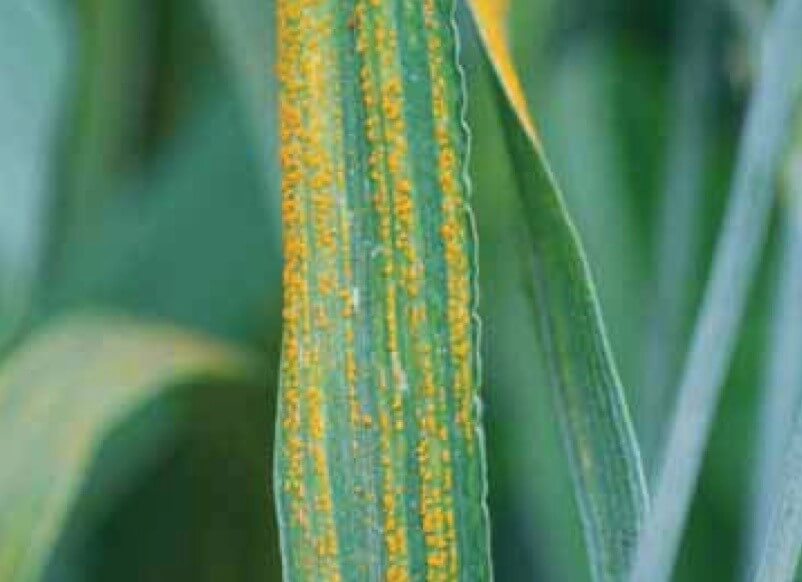Kansas: "Weather conditions the past two weeks was very conducive for further spread of stripe rust with cool temperatures and frequent rainfall. Therefore, additional finds of the disease are very likely." Erick De Wolfe, Extension Plant Pathologist, Kansas State University
Oklahoma: "Powdery mildew is heavy on the lower leaves and spreading to mid-level leaves in wheat that has a heavy canopy. Dr. Misha Manucheehri (ast Prof & Weed Scientist, OSU) reported finding some heavier leaf rust in her experimental plots at Perkins, OK." Bob Hunger, Extension Wheat Pathologist, Oklahoma State University.
What is Stripe Rust?
The fungus Puccinia striigormis causes wheat stripe rust. The fungus has specialized forms that are able to infect either wheat or barley. Stripe rust is favored by cool, humid weather and disease development is most rapid between 50 and 60 degrees Fahrenheit. The disease is inhibited when night-time temperatures get above 68 degrees Fahrenheit or there are several days in a row in the mid 80s. Stripe has the potential to cause losses of 40 percent or more when the disease becomes established on susceptible varieties before heading. Symptoms of stripe rust include long stripes of small yellow or orange blister-like lesions called "pustules". The disease primarily occurs on the leaves; however, glumes and base of the awns also can be affected. The blister-like lesions produce large amounts of spores that are easily dislodged. Theses spores may appear as orange dust on the clothing of individuals that have recently walked through heavily disease fields.
K-State Research and Extension - Wheat Stripe Rust
Purdue University - Managing Wheat Growth by Stage

Wheat Stripe Rust
Photo taken from K-State Research and Extension
Quick Facts
- Stripe rust typically produces yellow or orange blister-like lesions that re arranged in stripes. The disease is most common on leaves but also can affect glumes and awns of some varieties.
- The fungus that causes stripe rust rarely survives the winter in Kansas and must be reintroduced from overwintering locations each season. Outbreaks of severe stripe rust in Texas and Oklahoma often indicate high risk of disease in Kansas.
- Planting disease-resistant varieties can effectively control stripe rust. A recent change in the stripe rust population has reduced the resistance of many popular varieties.
- Foliar fungicides also can be used to control the disease. The most effective fungicide applications are typically applied at the boot stage of crop growth and provide protection of the upper leaves during the early stages of grain development. Products containing a triazole fungicide are considered the best option when the disease is established in a field.
Control/Treatment – Fungicide Application
Planting disease-resistant varieties is the most effective and economical way to control stripe rust. Foliar fungicides can effectively control stripe rust. According to K-State Research and Extension, when fungicides are applied to the crop at the boot stage of development, the fungicides should provide protection for the upper leaves that contribute most of the energy used to produce grain. Many products have specific use restrictions and may be present on the amount of active ingredient that can be applied within a period of time or on the number of sequential applications that can occur. Use of the fungicides have been approved by the EPA (United States Environmental Protection Agency).
____________________________________________________________________
Contact Tyree Ag today to discuss which fungicide
product is best to meet your needs.

Toll Free: 866-897-3324
*Current customers please contact your salesman or call the office, where your information
will be given to a salesman who will contact you directly.
________________________________________________________________________
How does stripe rust impact wheat yield?
There will be a yield loss to those fields that are impacted by stripe rust. This disease can reduce the number of kernels per spike, test rates, and kernel quality. These yield losses will then impact the farmers who produce the world’s food and overall decrease wheat yield across all producers.
*Information for this blog was taken from K-State Research and Extension and Purdue University (both files attached through the links above).
KP
